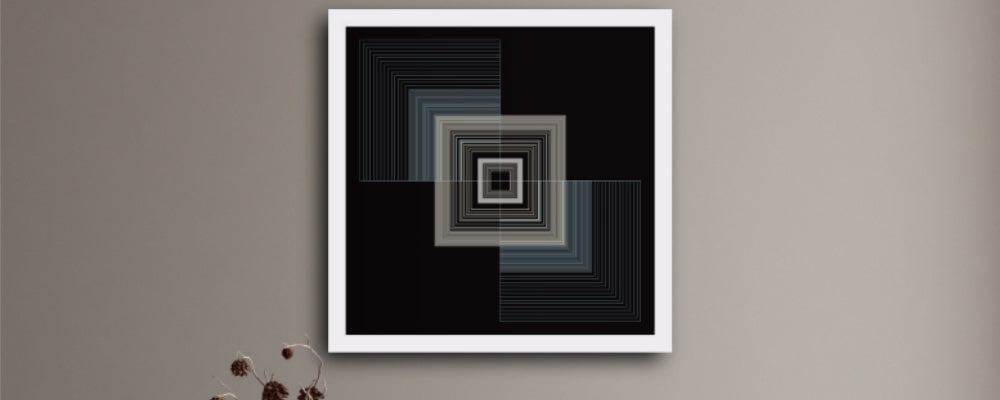
How to Frame Prints? Framing Art Prints:
There are many different types of frames to choose from. Whether it’s a Gallery Frame, Modern, Floating, Deep Set, Canvas, Box or Tabletop Frame – your frame should complement the subject and draw your eye to the print’s focal point. Before we get into the colour of your frame, it’s time to consider the framing materials.
Acrylic vs Glass
When it comes to framing and glazing, it can be hard to know whether acrylic or glass is the better choice. While it often comes down to personal preference on the look of the frame and how the print is displayed, there are a few key differences to consider. So, what are they?
Acrylic Glazing Within Your Frame
Because acrylic is lighter to transport and hang, it is a popular choice for collectors of large and very large pieces of artwork. There’s no risk of it shattering, but it’s also a softer material, so should only be cleaned with a microfibre cloth. Like glass, acrylic is available as museum quality, UV safe and low sheen options for minimal reflection.
Glass Glazing Within Your Frame
Glass is significantly heavier than acrylic. It is less likely to scratch, but more fragile and so harder to transport. In larger frames, you may need to provide the frame with extra support to counteract the weight of the glass. In some cases, condensation can also get trapped beneath the glass, causing damage to your print, but some people prefer the look of a glass frame over an acrylic one. When you’re ready to frame your work, it’s worth noting that there are differences in the quality of both glass and acrylic options available to protect your print.
• Clear Glass or Acrylic: Inexpensive and readily available so used in cheaper frames. Protects against dust and marks but has no ultraviolet (UV) protection. Suits low-value artwork or posters.
• Non-Reflective Glass: Etched on one side to reduce reflections so best in a space with lots of light. However, it offers no UV protection so best for low-value artwork, or posters that don’t feature fine details as the etching can cause some clarity to be lost.
• UV Conservation Glass (comes in both clear and non-reflective): Protects valuable artworks from 99% of UV light. Choose non-reflective option that won’t be affected by the loss of clarity.
• Museum Grade Glass or Acrylic: Premium glass that offers 99% UV protection and less than 1% reflection. This has the highest brightness and optical coating so as not to affect colour transmission as some cheaper glass options have a green tint to them. Museum quality acrylic has anti-static technology, to prevent dust from pastels and charcoal art being attracted to the frame. These options are best for valuable artworks that need to be displayed professionally.

UV Protection
This is a must for protecting your wall hangings. Ultraviolet radiation light from the sun, as well as many light bulbs, can damage your print through exposure over time. If you’re going to invest in an archival quality print like mine, I recommend investing in a glass glaze or acrylic that is enhanced with UV-protective coatings. Your print does not have to be in direct sunlight for the UV radiation to affect it, and you’ll notice the difference over time.
Choosing The Colour Of Your Frame
When choosing your frame, you should consider the size, shape and colour of your piece as well as your existing décor and wall colour. Ideally, your frame should highlight focal points within the print, without overpowering it. For example, my Tangerine Dream geometric print looks great with an angled frame and small surrounding matt to let the piece breathe. A detailed image such as a cityscape would pair nicely with a modern gallery frame, that features a larger surrounding matt to highlight the piece.
Thin black frames have an understated, elegant yet modern feel to them and work well as an understated border to a canvas print. Remove the matt from a standard print, and the dark frame can help emphasise deep tones and subdued themes within the art. White or floating frames work best with high impact, colourful artwork where a dark frame would only be distracting. Brushed metal frames suit industrial spaces and edgy artworks.

Woodgrain frames can add a softness to a room or accentuate a coastal theme and highlight softer lines within the art or darker wood frames be used for colonial styled houses.

The right choice of frame will ensure the viewer’s focus remains on central themes of work, so before buying your frame, decide where you’ll hang your print and take note of the décor, the textures and the colours within the print and the room. It's then a simple process of colour matching.
Ask yourself:
• Which aspects of your print attract your eyes?
• Which parts do you want to accentuate?
• What colours within your décor and print can you highlight with your frame.
Gilded Decorative Frames


Gilding is the process of applying a thin layer of gold or silver leaf to what is often a more intricate frame. It’s a more traditional option, that historically, has been associated with wealth and beauty. Because of the level of detail and precision in creating gilded frames, they’re often considered to be works of art in their own right. Gilding was once common for many household items, frames, candelabras and more and if you have an antique, heirloom items, it’s worth investing some time and effort to look after it to help maintain its value. However, you can also buy new ones today. Gilded frames pair perfectly with artwork with a vintage feel, such as old or formal photographs, family photos and historical work.



